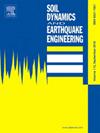Multi-hazard fragility analysis of cross-sea cable-stayed bridges cable bent tower under seismic-wind combined action
IF 4.6
2区 工程技术
Q1 ENGINEERING, GEOLOGICAL
引用次数: 0
Abstract
Cable-stayed bridges are one of the primary bridge types for large-span cross-sea bridges, especially in earthquake-prone regions. These bridges face not only the threat of seismic disasters but are also continuously exposed to the adverse effects of strong winds. Under the combined influence of both earthquakes and wind loads, the safety of cable-stayed bridges has become a key focus in disaster-resilience research. However, research on the disaster-resilient performance of cable-stayed bridges under multi-hazard interactions remains relatively limited. Therefore, this study focuses on the multi-hazard fragility of cross-sea cable-stayed bridges' main load-bearing component, the towers. First, a finite element model of the entire cable-stayed bridge is developed, followed by the construction of a cable-stayed bridge tower model through static and dynamic equivalence. Based on the Pacific Earthquake Engineering Research Center (PEER) database, seismic wave data is selected. Different heights of fluctuating wind speeds for the tower are simulated and converted into concentrated force time-history curves. Through nonlinear time-history analysis, the multi-hazard fragility of the tower in cable-stayed bridges under seismic-wind combined action is studied. The results show that seismic-wind combined action leads to increased dynamic responses of the tower of cable-stayed bridges. Taking the case of slight damage to the tower under the combined action of rare seismic and different wind speeds (30, 40, 50 m/s) as an example, the probabilities are 15.9 %, 17.0 %, and 20.1 %, respectively. Compared with the seismic action alone, there was an increase of 1.3 %, 2.4 %, and 5.5 % respectively. Under seismic-wind combined action, the fragility of the tower significantly increases. However, as the seismic intensity increases, the influence of wind speed on tower damage gradually decreases, and the extensive damage degree of the tower is mainly controlled by seismic action.
地震-风联合作用下跨海斜拉桥斜拉塔多危易损性分析
斜拉桥是大跨度跨海桥梁的主要桥型之一,特别是在地震多发地区。这些桥梁不仅面临地震灾害的威胁,而且还不断受到强风的不利影响。在地震和风荷载的共同作用下,斜拉桥的安全性已成为抗灾研究的热点。然而,对多灾种作用下斜拉桥抗灾性能的研究相对有限。因此,本研究的重点是跨海斜拉桥的主要承重构件塔架的多危易损性。首先建立整个斜拉桥的有限元模型,然后通过静力和动力等效建立斜拉桥塔架模型。基于太平洋地震工程研究中心(PEER)数据库,选取地震波数据。模拟了塔体不同高度的脉动风速,并将其转化为集中力时程曲线。通过非线性时程分析,研究了地震-风共同作用下斜拉桥塔身的多危易损性。结果表明,地震-风共同作用导致斜拉桥塔身动力响应增大。以罕见地震和不同风速(30、40、50 m/s)共同作用下塔体轻微损坏为例,概率分别为15.9%、17.0%和20.1%。与单独的地震作用相比,分别增加了1.3%、2.4%和5.5%。在地震和风的共同作用下,塔的易损性明显增加。但随着地震烈度的增大,风速对塔损的影响逐渐减小,塔损的广泛程度主要由地震作用控制。
本文章由计算机程序翻译,如有差异,请以英文原文为准。
求助全文
约1分钟内获得全文
求助全文
来源期刊

Soil Dynamics and Earthquake Engineering
工程技术-地球科学综合
CiteScore
7.50
自引率
15.00%
发文量
446
审稿时长
8 months
期刊介绍:
The journal aims to encourage and enhance the role of mechanics and other disciplines as they relate to earthquake engineering by providing opportunities for the publication of the work of applied mathematicians, engineers and other applied scientists involved in solving problems closely related to the field of earthquake engineering and geotechnical earthquake engineering.
Emphasis is placed on new concepts and techniques, but case histories will also be published if they enhance the presentation and understanding of new technical concepts.
 求助内容:
求助内容: 应助结果提醒方式:
应助结果提醒方式:


